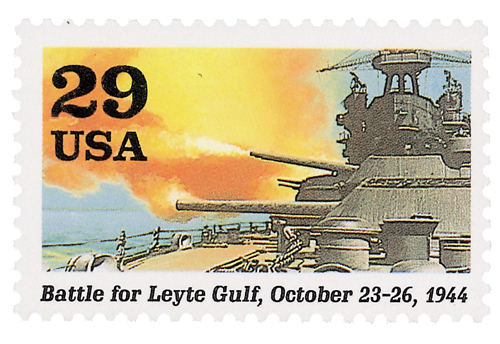
# PH486 - 1945 4c Philippines, yellow green
Battle Of Leyte Gulf
Ten hours after the Japanese attack on Pearl Harbor on December 7, 1941, they invaded the Philippines. Months earlier, General Douglas MacArthur had been called out of his retirement to command U.S. Army forces there. Following that invasion, he and his men retreated to the Bataan Peninsula and later Corregidor.
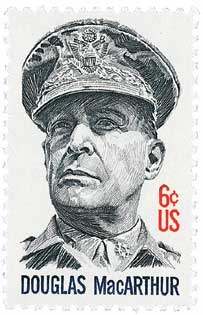
By February 1942, the situation was bleak and President Roosevelt ordered MacArthur to leave for Australia. Forced to leave his men behind, MacArthur did as he was ordered, but promised, “I shall return.” The 70,000 American and Philippine men he left behind were captured that April and taken on a lengthy death march that claimed thousands of their lives. After Corregidor surrendered a month later, the Philippines were in complete Japanese control.
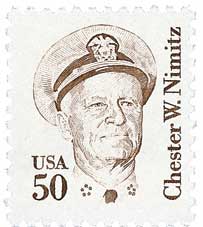
At first, the Allies had no immediate plans to liberate the Philippines. But by 1944, campaigns in New Guinea and the Central Pacific brought MacArthur’s forces within striking distance of the Philippines.
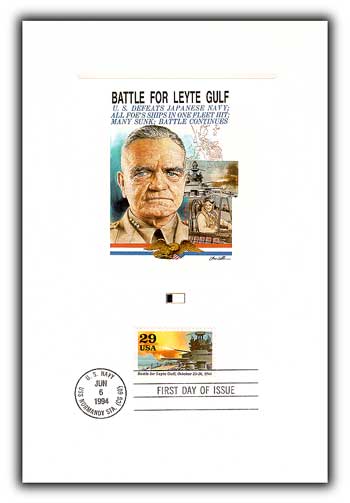
Following extensive debate, Allied leaders decided to liberate the Philippines in late 1944. Expecting fierce fighting from the Japanese, the Allies assembled the largest landing force ever used in a Pacific campaign – more than 750 ships participated in the invasion. Fulfilling his promise “I shall return,” MacArthur waded ashore at Palo beach on October 20, 1944. It had taken MacArthur more than two and a half years and many brutal battles to keep his pledge made at Corregidor.
In response, the Japanese developed a plan, Sho-Go 1, which would split their Navy into four forces. The Center Force began battle with Allied ships on October 23 at the Battle of the Sibuyan Sea, losing three ships.
The next day, the Southern Force met the Allies in the Suriago Strait, losing three more ships and being forced to withdraw. American Admiral William Halsey watched as Japanese ships left the strait and followed, leaving the landings at Leyte unprotected. This was the Japanese plan all along.
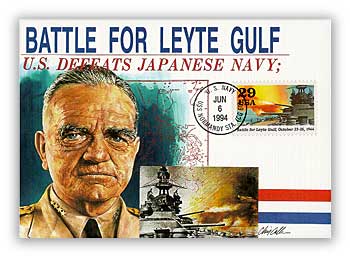
After sinking another four Japanese ships, Halsey learned of the critical state at Leyte and quickly retuned. Though the Japanese had a larger force, they retreated, fearing potential attacks by American aircraft. In the end, the Japanese lost 27 ships, more than 10,000 sailors, and most of their airplanes. The battle marked the Japanese Navy’s last large-scale operation. Despite Japan’s new strategy, the battle ended in a major victory for the United States. The Japanese Navy had been crushed, leaving Japan unprotected and exposed to an assault.
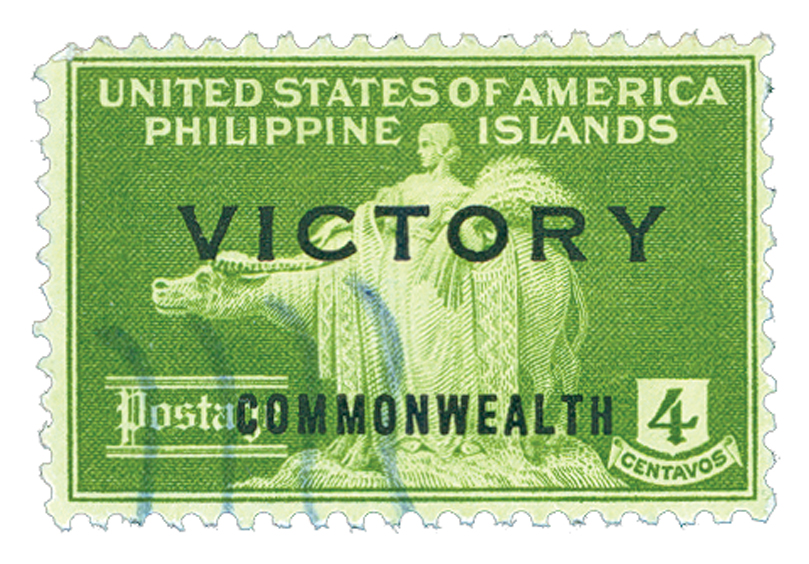
The Battle for Leyte Gulf is often considered the greatest naval battle in history. In a desperate last effort to win the war, the Japanese unleashed a terrifying new weapon – kamikazes – suicide pilots who would crash planes filled with explosives onto Allied warships. Before the war ended they had sunk or damaged over 300 U.S. ships.
Click here to see lots of photos from the Philippine Campaign and Leyte Gulf.
Battle Of Leyte Gulf
Ten hours after the Japanese attack on Pearl Harbor on December 7, 1941, they invaded the Philippines. Months earlier, General Douglas MacArthur had been called out of his retirement to command U.S. Army forces there. Following that invasion, he and his men retreated to the Bataan Peninsula and later Corregidor.

By February 1942, the situation was bleak and President Roosevelt ordered MacArthur to leave for Australia. Forced to leave his men behind, MacArthur did as he was ordered, but promised, “I shall return.” The 70,000 American and Philippine men he left behind were captured that April and taken on a lengthy death march that claimed thousands of their lives. After Corregidor surrendered a month later, the Philippines were in complete Japanese control.

At first, the Allies had no immediate plans to liberate the Philippines. But by 1944, campaigns in New Guinea and the Central Pacific brought MacArthur’s forces within striking distance of the Philippines.

Following extensive debate, Allied leaders decided to liberate the Philippines in late 1944. Expecting fierce fighting from the Japanese, the Allies assembled the largest landing force ever used in a Pacific campaign – more than 750 ships participated in the invasion. Fulfilling his promise “I shall return,” MacArthur waded ashore at Palo beach on October 20, 1944. It had taken MacArthur more than two and a half years and many brutal battles to keep his pledge made at Corregidor.
In response, the Japanese developed a plan, Sho-Go 1, which would split their Navy into four forces. The Center Force began battle with Allied ships on October 23 at the Battle of the Sibuyan Sea, losing three ships.
The next day, the Southern Force met the Allies in the Suriago Strait, losing three more ships and being forced to withdraw. American Admiral William Halsey watched as Japanese ships left the strait and followed, leaving the landings at Leyte unprotected. This was the Japanese plan all along.

After sinking another four Japanese ships, Halsey learned of the critical state at Leyte and quickly retuned. Though the Japanese had a larger force, they retreated, fearing potential attacks by American aircraft. In the end, the Japanese lost 27 ships, more than 10,000 sailors, and most of their airplanes. The battle marked the Japanese Navy’s last large-scale operation. Despite Japan’s new strategy, the battle ended in a major victory for the United States. The Japanese Navy had been crushed, leaving Japan unprotected and exposed to an assault.

The Battle for Leyte Gulf is often considered the greatest naval battle in history. In a desperate last effort to win the war, the Japanese unleashed a terrifying new weapon – kamikazes – suicide pilots who would crash planes filled with explosives onto Allied warships. Before the war ended they had sunk or damaged over 300 U.S. ships.
Click here to see lots of photos from the Philippine Campaign and Leyte Gulf.







